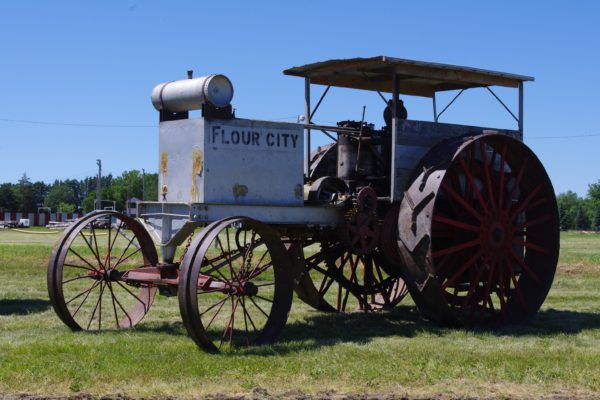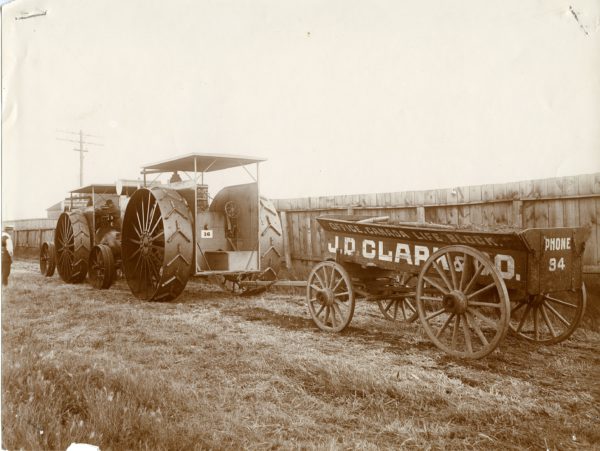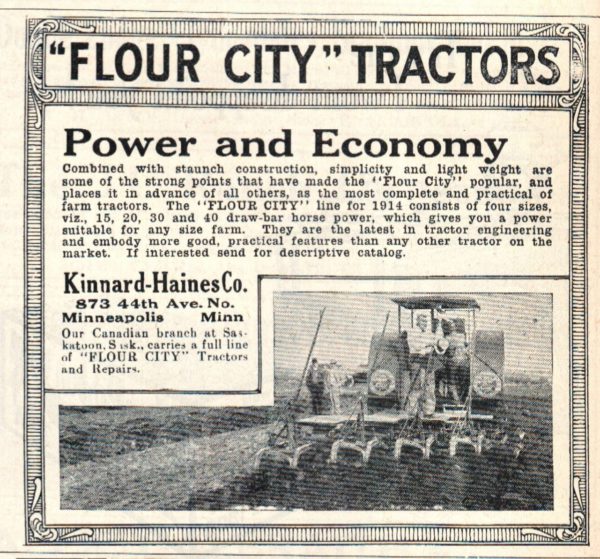
The Museum’s collection includes a Flour City 30-50 tractor which was donated to the Museum in 1961. The 30-50 was purchased by a Mr. Lewis and used on his farm near Stonewall, Manitoba. The tractor was purchased by Mr. Lewis from the Winnipeg Light Agricultural Motor Competition in 1909 making this tractor the only tractor in existence known to have participated in this important event.

The Winnipeg Motor Competitions were a feature of the Winnipeg Industrial Exhibition from 1908 to 1913. The word motor was used in the pre-World War One period to describe what is now known as a tractor. The Winnipeg Motor Competitions were an important event in the development of the tractor as the event was the very first attempt to scientifically measure the drawbar horsepower, belt pulley horsepower, fuel economy and other features of tractors that farmers were interested in. Farmers and others interested in tractors could see the machines actually plowing, driving pony brakes and pulling wagons. By comparing the results of the power and fuel economy measurements, interested people could draw better conclusions as to which tractors were suited to their operations.

Flour City tractors were built by the Kinnard –Haines Company. Kinnard-Haines was formed out of the Kinnard Press Company in 1901. The Kinnard Press Company was started in 1882 in Minneapolis, Minnesota and manufactured hay presses, single mills, saw mills and similar machinery. By the 1890s Kinnard Press had branched into manufacturing stationary engines. As Minneapolis was known for the milling of flour, Kinnard Press decided to call their stationary engine line, the Flour City line. In 1896, the Kinnard Press Company decided to get into the tractor business. By 1897, the company had managed to produce a tractor using a Flour City single cylinder stationary engine. A chain from the flywheel of the engine drove a shaft on which was mounted a clutch. From there, the drive wheels were powered by bull gears and pinons. Four tractors were built in 1898 and a further 28 in 1899. The tractor line also was called Flour City. These early tractors were built for belt work only. A twin cylinder Flour City tractor appeared in 1900.
Kinnard-Haines over time became convinced through testing that the future of the farm motor or tractor lay with a four cylinder, valve in head engine that was mounted vertically. By 1908, Kinnard-Haines had developed an all new 4 cylinder engine and come out with the 30-50 Flour City. In this design the company followed the principals of;
- Developing and employing a fuel efficient engine with abundant horsepower
- Substantial construction
- Keeping weight down without sacrificing strength
- Carrying a greater percentage of weight over the drive (back) wheels than over the front wheels
- Designing a tractor that was easily handled
An oddity of the engine design was the use of split crankshaft design. It came in two pieces that were bolted together between the number 2 and number 3 cylinders. This was done so if the crankshaft broke then only the broken half had to be replaced. As well, the crankshaft could be replaced in the field if necessary.
Kinnard-Haines succeed with these principals as the company’s Flour City tractors won four Gold Medals in the Winnipeg Motor Trials through 1908 and 1909. The 30-50 entered in the 1910 trials was sidelined after a new clutch using cork facings proved unsuitable for use as the cork became contaminated with oil and failed to hold. The company returned to the trials in 1911 but did not participate in the 1912 and 1913 trials.
Flour City tractors were also produced in other models such as the 40-70 which came out in 1910, the 20-35 which came out in 1911, the Flour City “Junior” 12-20 which came out in 1918 but only was in production for one year and the 15-25 which appeared at the end of 1918 but again only stayed in production for one year. In 1919, the 14-24 had appeared. The 14-24, 20-35, 30-50 and 40-70 stayed in production until 1927. By that time the day of the heavy weight tractors was long gone and the Kinnard-Haines designs were obsolete.
The company was sold in 1929 to the Bros Steel Products Company but parts were still available for Flour City tractors until 1934.


